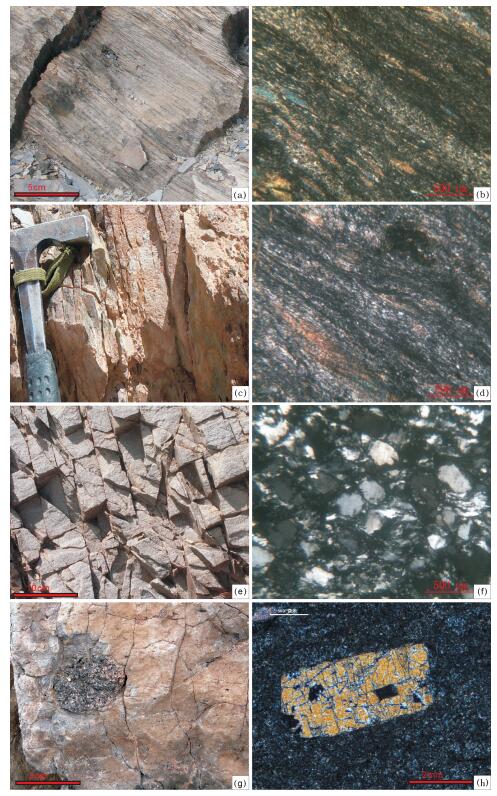The establishment of Ediacaran Dabure Formation in southern Qiangtang of northern Tibet and its significance
-
摘要:
羌塘位于青藏高原腹地,构造上处于冈瓦纳大陆北缘。因其特殊的构造位置,羌塘地体的起源及构造演化对于探讨青藏高原的早期形成演化、冈瓦纳大陆裂解,以及特提斯洋演化等关键科学问题至关重要。最近,在羌塘南部达布热地区发现一套碎屑岩夹玄武岩的岩石组合,碎屑岩具有低成分成熟度的特点,虽然岩石发生了低绿片岩相变质,但仍然保留了原岩类复理石沉积的特点。根据碎屑锆石定年结果,该套地层中碎屑锆石的最年轻年龄为550Ma左右。此外,该套地层中玄武岩夹层的测年结果表明,该套地层形成于埃迪卡拉纪(约550Ma)。结合地层剖面及区域地层对比,建立了埃迪卡拉纪达布热组。达布热组是羌塘地区首次发现的埃迪卡拉纪地层,该组地层的建立为探讨冈瓦纳大陆北缘构造演化提供了重要线索。
Abstract:The Qiangtang terrane is situated in the hinterland of the Tibetan Plateau on the northern margin of Gondwana. Because of its particular tectonic location, the understanding of the origin and tectonic evolution of the Qiangtang terrane is important in examining the formation and evolution of the Tibetan Plateau, the breakup of the Gondwana supercontinent, and the evolution of the Tethys Ocean. The Dabure clastic rocks discovered recently are characterized by low compositional and textural maturity, and have been affected by lower greenschist facies metamorphism. The deposits exhibit the typical features of turbidites. Based on detrital zircons U-Pb dating, the authors obtained the most reliable youngest age of detrital zircons from the Dabure clastic rocks, which is ca. 550Ma. Combining the data obtained by the authors with previous work on the basalts in the Dabure area (the Dabure basalts), the authors tentatively suggest that the Dabure clastic rocks represent the late Ediacaran (ca. 550Ma) sedimentary record of the Qiangtang terrane. On the basis of section measurement and regional correlation, the Ediacaran Dabure Formation was established. The establishment of the Dabure Formation not only has important theoretical significance for revealing the evolutionary history of the Qiangtang terrane in late Neoproterozoic but also provides new clues for tectonic evolution of the northeastern margin of Gondwana.
-
Keywords:
- Tibetan Plateau /
- southern Qiangtang /
- clastic rocks /
- basalt /
- Ediacaran
-
羌塘地处青藏高原北部,南以班公湖-怒江缝合带与冈底斯板块相隔,北以金沙江缝合带与拉萨和松潘-甘孜板块相接[1-4],构造上处于冈瓦纳大陆与欧亚大陆的交汇部位,是研究特提斯演化的关键区域。近些年,围绕特提斯演化、冈瓦纳大陆北界等课题,在羌塘中部不断有蛇绿岩和高压变质带(榴辉岩和蓝片岩)的发现和报道[5-14]。这些研究成果表明,羌塘中部的龙木错-双湖-澜沧江板块缝合带可能代表古特提斯主洋盆闭合的遗迹[15-19]。以该缝合带为界,羌塘可进一步划分为羌南和羌北2个板块(图 1)。近期,笔者等在羌塘南部的达布热地区发现了一套碎屑岩夹玄武岩的岩石组合(原擦蒙组),岩石类型主要为变质石英砂岩、变质含砾砂岩、千枚岩、板岩等夹数层玄武岩。野外观察发现,该套地层与周围广泛发育的晚古生代裂谷型沉积(擦蒙组/展金组)为断层接触,北部被第四系直接覆盖。玄武岩夹层中锆石的U-Pb测年及该套地层中碎屑锆石的测年结果显示,该套地层形成于新元古代晚期埃迪卡拉纪。该套地层在岩性组合、形成时代等方面与真正意义上的擦蒙组存在较大差别。因此,遵照《中国地层指南及中国地层指南说明书》中关于划分岩石地层单位的规定[22],将羌塘南部达布热地区1:25万丁固幅[23]圈定的擦蒙组重新厘定为埃迪卡拉系达布热组(Edd),这是羌塘地区首次发现的埃迪卡拉纪沉积地层。
1. 达布热组地质特征
研究区位于羌塘南部的达布热地区,地层分区属羌南地层区。出露的地层主要为晚石炭世—早二叠世冈瓦纳大陆北缘裂谷型沉积展金组。羌塘南部由于构造破坏,地层出露不连续,但却保存有较完整的蛇绿岩及高压变质带,成为龙木错-双湖-澜沧江板块缝合带的主体部分。本次新建立的达布热组出露面积约15km2,厚度大于750m。出露位置位于羌塘南部冈玛错南约30km处,位于龙木错-双湖-澜沧江板块缝合带以南地区。岩性为一套变质碎屑岩夹玄武岩,岩石类型主要为千枚岩(图版Ⅰ-a、b)、板岩(图版Ⅰ-c、d)、变质石英砂岩(图版Ⅰ-e、f)等,夹数层玄武岩(图版Ⅰ-g、h),但该套地层中未见冰海杂砾岩,且其与周围广泛发育的石炭纪—二叠纪裂谷型沉积为断层接触,北部被第四系直接覆盖(图 1)。
2. 建组剖面描述
达布热组实测剖面如图 2所示。剖面位于改则县察布乡北约50km的达布热地区(图 1),剖面起点的地理坐标为北纬33° 35′ 35″、东经84° 14′ 15″。由于构造和全新统沉积覆盖,地层未见顶底。剖面自上而下分16层,可以划分出3个岩性段,具体描述如下。
![]() 图 2 羌塘南部地区达布热组地层实测剖面图(据参考文献[21]修改)1—冲洪积物;2—板岩;3—千枚岩;4—冰海杂砾岩;5—变质石英杂砂岩;6—玄武岩;Qhpal—第四系冲洪积物;C2P1z—上石炭统-下二叠统展金组冰海杂砾岩;Edd1—达布热组一段;Edd2—达布热组二段;Edd3—达布热组三段Figure 2. Measured geological section of Dabure Formation in southern Qiangtang
图 2 羌塘南部地区达布热组地层实测剖面图(据参考文献[21]修改)1—冲洪积物;2—板岩;3—千枚岩;4—冰海杂砾岩;5—变质石英杂砂岩;6—玄武岩;Qhpal—第四系冲洪积物;C2P1z—上石炭统-下二叠统展金组冰海杂砾岩;Edd1—达布热组一段;Edd2—达布热组二段;Edd3—达布热组三段Figure 2. Measured geological section of Dabure Formation in southern Qiangtang16.全新统冲洪积物
~~~~~~~~~~~~~~~~~~未见顶~~~~~~~~~~~~~~~~~~
达布热组三段(Edd3)
15.灰绿色薄层板岩:天然露头好,中等风化,岩石风化面黄褐色、土黄色,新鲜面青灰色,变余泥质结构,板状构造
26.7m
14.灰绿色薄层千枚岩夹薄层粉砂岩:天然露头较好,中等风化,岩石风化面土黄色,新鲜面青灰色,鳞片变晶结构,千枚状构造 57.1m
13.灰绿色厚层变质玄武岩:天然露头好,弱风化,岩石风化面黄褐色,灰黑色,新鲜面灰绿色,变余斑状结构,斑晶含量可达3%,粒度可达1~2cm,主要为辉石,其次为橄榄石,辉石肉眼即可观察到2组近直交解理。岩石为层状构造 37.2m
12.灰绿色薄层千枚岩夹薄层粉砂岩:天然露头中等,中等风化,岩石风化面土黄色、黄绿色,新鲜面为青灰色,鳞片变晶结构,千枚状构造 47.7m
达布热组二段(Edd2)
11.灰绿色板岩:天然露头较好,中等风化,岩石风化面黄褐色、土黄色,新鲜面青灰色,变余泥质结构,板状构造 29.4m
10.灰绿色中-薄层变质玄武岩:天然露头好,中等风化,岩石风化面黄褐色、灰黑色,新鲜面灰绿色,变余斑状结构,斑晶主要为原岩残留的斜长石及辉石,层状构造,单层厚度为5~10cm,岩石中见有围岩捕虏体,捕虏体含量可达1%~3%,主要为石英砂岩 37.2m
9.灰绿色千枚岩:天然露头中等,岩石风化后呈碎片状散落于地表,该层总体出露厚度较大,岩石风化面黄褐色或青灰色,新鲜面为青灰色,鳞片变晶结构,千枚状构造 77.5m
8.灰绿色厚层变质玄武岩:天然露头好,中等风化,岩石中见大量的捕虏体及斑晶,斑晶粒度一般为1~15mm,大者可达3cm,主要为辉石及少量橄榄石,含量占岩石总体积的1%~ 2%,捕虏体主要为石英砂岩及少量板岩,粒度在1~5cm之间。岩石风化面黄褐色,新鲜面灰绿色,变余斑状结构,层状构造
56.3m
7.灰绿色薄层千枚岩夹薄层粉砂岩:天然露头好,弱风化,风化面土黄色,新鲜面为青灰色,鳞片变晶结构,千枚状构造
43.8m
6.青灰色厚层变质玄武岩:露头好,弱风化,岩石风化面黄褐色,新鲜面灰绿色,变余斑状结构,层状构造。岩石中斑晶数量减少,含量不足1%,主要为辉石及少量的橄榄石,粒度在1~4mm之间。捕虏体含量增加,含量约为8%,主要为板岩及少量石英砂岩,粒度一般在1~5cm之间 89.3m
达布热组一段(Edd1)
5.灰绿色板岩:天然露头较好,中等风化,岩石风化面黄褐色、土黄色,新鲜面青灰色,变余泥质结构,板状构造 34.2m
4.灰绿色千枚岩:露头较好,中等风化,风化面土黄色,新鲜面为青灰色,鳞片变晶结构,千枚状构造 80.1m
3.灰白色变质细粒石英杂砂:露头好,弱风化,岩石坚硬致密,成分主要为石英及少量的杂基,风化面红褐色、土黄色,新鲜面灰白色。变余细粒碎屑结构,变余层理构造
56.4m
2.灰白色变质粗粒石英杂砂岩:天然露头好,中等风化,成分主要为石英及少量杂基,风化面红褐色,新鲜面土黄色。变余粗粒碎屑结构,变余层理构造 77.9m
————————断层————————
1.上石炭统—下二叠统展金组冰海杂砾岩(C2P1z),天然露头较好,岩石风化面为土黄色,新鲜面为青灰色或浅灰色,杂基支撑结构,砾石的分选性差,磨圆为次圆状,砾石的砾径多在2~3cm之间,成分复杂,主要为砂岩、灰岩及少量的玄武岩等,厚层状构造。可见明显的砾石刺穿层理现象 >105m
3. 达布热组地层时代及沉积环境
达布热碎屑岩分布于龙木措-双湖缝合带以南,由于没有年代学依据,1:25万丁固幅地质调查报告[23]将该套碎屑岩定为上石炭统擦蒙组,与其下部的展金组为整合接触,但是在该区并未获得可靠的化石年龄或同位素年龄数据。一般认为,展金组的时代是晚石炭世—早二叠世[24-26],且展金组的最小年龄峰值约为500Ma[27]。羌塘中部温泉石英岩的最年轻碎屑锆石年龄为525Ma[28]。通过对该套地层中所夹玄武岩的测年,获得了3件玄武岩的测年结果,分别为557±17Ma、547±8Ma、551±6Ma。另外,4件碎屑岩锆石样品中获得的最小锆石年龄值约为550Ma[20-21],进一步说明达布热碎屑岩形成于新元古代晚期,是迄今为止羌塘地区首次发现的埃迪卡拉纪地层。然而,由于在羌塘地区大面积分布的裂谷型沉积并没有确切的时代依据,所以达布热组在羌塘地区的确切分布尚不清楚。达布热组保存有较完整的鲍马沉积序列,反映出浊流沉积的特点[21],可识别出3个沉积旋回,每个旋回代表一次浊流沉积,反映了深水-半深水浊流的沉积特征。达布热碎屑岩中玄武岩夹层形成于大陆板内裂谷环境,其源区可能为富集型地幔[20]。
4. 达布热组的地质意义
4.1 青藏高原新元古代晚期的沉积记录
羌南地区出露数万平方千米的浅变质岩系夹基性火山岩,对这套地层的时代、成因和构造属性的认识争论非常大[29-33],而达布热碎屑岩正是从这套浅变质岩石中识别出来的。目前在羌塘南部地区能够确定的最早的生物组合为早奥陶世阿伦尼克期[34]。1:25万玛依岗日幅区域地质调查[35]在羌塘东部的玛依岗日至冈塘错之间的一套中浅变质岩中发现了大量的鹦鹉螺化石,在此基础上建立了塔石山组,时代为奥陶纪,确立了羌塘南部地区早古生代地层的存在。此外,董春燕等[28]通过对荣玛地区温泉石英岩的碎屑锆石测年,获得最年轻的碎屑锆石年龄为525Ma。杨耀等[36]研究认为,羌南荣玛地区浅变质石英砂岩形成于寒武纪中晚期,与上覆中、上奥陶统塔石山组为平行不整合接触,命名为荣玛组,归入寒武系,但是关于该组的时代有待进一步研究确认。羌北地区目前发现的最老地层为早泥盆世中晚期平沙沟组(D1p)。在青海省玉树的长青可、小苏莽、江达、罗麦地区到巴塘以西的金沙江西岸曾报道存在中、新元古界[37-38],但是目前仍然缺乏确凿的年代学证据。达布热组是目前羌塘地区首次报道的埃迪卡拉纪地层,同时也是羌塘地区有时代依据的最古老地层。在青藏高原的其他板块上,早古生代及其之前的沉积记录也少见,而且主要分布于青藏高原南部地区,大多数这类地层被笼统地划归震旦纪—中寒武世,但是均缺少可靠的年代学依据。例如在拉萨板块上出露的最老地层时代被认为是中元古代—寒武纪,以念青唐古拉岩群为代表[39-40],该地层在拉萨板块的东部和南部被称为林芝岩群或冈底斯岩群。有学者认为,该套地层的形成时代为750~790Ma[41],然而关于该套地层的时代尚有不同的认识[42-43]。在安多地区也报道了一批新元古代的年龄数据,以安多片麻岩为代表[44-46],但是其时代和岩性均与达布热碎屑岩不同。
在青藏高原南部的喜马拉雅及冈底斯南部地区,发育有与达布热碎屑岩时代和沉积特点相近的地层,时代被认为是震旦纪—中寒武世[47],例如高喜马拉雅地区的肉切村群、低喜马拉雅地区的米里群、冈底斯地区的波密群、保山地区的公养河群(伴有基性岩浆活动)、缅甸的Chaung Magyi群等。这些地层同样具有类复理石沉积的特点。在其他岩石学记录方面,达布热碎屑岩的形成时代比目前羌塘地区报道的最老的岩石学记录(堆晶岩测年结果517Ma)要早数十个百万年。正因如此,达布热碎屑岩的发现为研究羌塘甚至青藏高原新元古代的演化历史打开了一扇窗。其不仅为恢复羌南板块新元古代晚期的古环境和古地理提供了非常重要的依据,也使研究者有机会探寻青藏高原更早期的构造演化历史。
4.2 特提斯洋演化的启示
大量证据显示,羌塘是冈瓦纳大陆北缘重要的组成部分[17-18, 48]。达布热碎屑岩中玄武岩形成时代为新元古代晚期,地球化学的初步研究表明,该玄武岩形成于大陆裂谷环境[20],同时也说明达布热碎屑岩的形成环境与裂谷作用有关,其成因很可能与冈瓦纳大陆早期裂解事件有关。近些年,围绕特提斯洋演化这一科学问题的研究取得很多新的进展,越来越多早古生代大洋存在的记录被报道[7-14];香桃湖地区发现了迄今为止羌塘地区首例早古生代基性高压麻粒岩,峰期变质年龄为427~422Ma[49]。这些研究成果再一次使羌塘成为学术界关注的焦点。然而,这些早古生代地质信息的发现对于探讨羌塘的早期演化历史远远不够,甚至新元古代的地质记录在羌塘地区没有任何报道。研究表明,达布热碎屑岩在沉积组合上明显具有类复理石沉积的特点,那么它能否作为特提斯最原始的沉积记录呢?当然这一大胆的假设并非毫无根据,因为达布热碎屑岩的出露位置距离龙木错-双湖缝合带不足20km,而且目前在龙木错-双湖缝合带上最老的蛇绿岩年龄为517Ma[14],最老的高压麻粒岩年龄为427Ma[49],所以大洋的演化应该还要向前推移。由此可见,达布热组很可能代表了特提斯洋初始裂解的沉积记录。
5. 结论
达布热组为一套变质碎屑岩夹玄武岩的岩石组合,自下而上可划分出3个岩性段,其在沉积特点上具有类复理石的岩石组合特点,反映了深水到半深水浊流的沉积特征。根据碎屑锆石定年结果,该套地层中碎屑锆石的最年轻年龄约为550Ma。此外,该套地层中玄武岩夹层的测年结果表明,该套地层形成于埃迪卡拉纪(约550Ma),是羌塘地区首次发现的埃迪卡拉纪地层,该组地层的建立为探讨冈瓦纳大陆北缘构造演化提供了重要线索。
致谢: 样品的测试工作得到中国地质大学(北京)地学实验中心老师和同学的大力支持,参加野外工作的还有吉林大学地球科学学院杨德明老师、广州地球化学研究所张修政博士、中国地质科学研究院胡培远博士、河海大学吴浩博士及吉林大学西藏科研队伍的同学们,在此一并致以诚挚的谢意。 -
图 2 羌塘南部地区达布热组地层实测剖面图(据参考文献[21]修改)
1—冲洪积物;2—板岩;3—千枚岩;4—冰海杂砾岩;5—变质石英杂砂岩;6—玄武岩;Qhpal—第四系冲洪积物;C2P1z—上石炭统-下二叠统展金组冰海杂砾岩;Edd1—达布热组一段;Edd2—达布热组二段;Edd3—达布热组三段
Figure 2. Measured geological section of Dabure Formation in southern Qiangtang
-
Allègre C J, Courtillot V, Tapponnier P A, et al. Structure and evolution of the Himalaya-Tibet orogenic belt[J]. Nature, 1984, 307:17-22. http://www.wanfangdata.com.cn/details/detail.do?_type=perio&id=JJ0231908924
Pierce J A, Mei H.Volcanic rocks of the 1985 Tibet Geotra verseLhasa to Golmud[J]. Phil. Trans. Roy. Soc. Lond., 1988, A327:203-213. http://www.jstor.org/stable/38187
Dewey J F, Shackelton R M, Chang C, et al.The tectonic evolution of the Tibetan Plateau[J]. Phil Trans. R. Soc. Lond., 1988, A327:379-413. http://d.old.wanfangdata.com.cn/Periodical/dxqy200906024
Searle M P, Cooper D J W, Rex A J.Collision tectonics of the Ladakh-Znaskar Himalaya[J]. Phil. Trans. R. Soc. Lond., 1991, A326:117-150.
Kapp P, Yin A, Mannin C E, et al. Blueschist-bearing metamorphic core complexes in the Qiangtang block reveal deep crustal structure of northern Tibet[J]. Geology, 2000, 28:19-22. doi: 10.1130/0091-7613(2000)28<19:BMCCIT>2.0.CO;2
李才, 翟庆国, 董永胜, 等.青藏高原羌塘中部发现榴辉岩及其意义[J].科学通报, 2006, 51:70-74. doi: 10.3321/j.issn:0023-074X.2006.01.014 李才, 董永胜, 翟庆国, 等.青藏高原羌塘早古生代蛇绿岩——堆晶辉长岩的锆石SHRIMP定年及其意义[J].岩石学报, 2008, 24(1):31-36. http://www.wanfangdata.com.cn/details/detail.do?_type=perio&id=ysxb98200801002 王立全, 潘桂棠, 李才, 等.藏北羌塘中部果干加年山早古生代堆晶辉长岩的锆石SHRIMP U-Pb年龄——兼论原-古特提斯洋的演化[J].地质通报, 2008, 27(12):2045-2056. doi: 10.3969/j.issn.1671-2552.2008.12.010 Zhai Q G, Li C, Huang X P. The fragment of Paleo-Tethys ophiolite from central Qiangtang, Tibet?-geochemical evidence of metabasites in Guoganjianian[J].Science in China(Series D), 2007, 50(9):1302-1309. doi: 10.1007/s11430-007-0051-7
胡培远, 李才, 李林庆, 等.藏北羌塘中部早古生代蛇绿岩堆晶岩中斜长花岗岩的地球化学特征[J].地质通报, 2009, 28(9):1297-1308. doi: 10.3969/j.issn.1671-2552.2009.09.019 吴彦旺, 李才, 董永胜, 等.藏北羌塘中部桃形湖早古生代蛇绿岩的岩石学特征[J].地质通报, 2009, 28(9):1290-1296. doi: 10.3969/j.issn.1671-2552.2009.09.018 董永胜, 张修政, 施建荣, 等.藏北羌塘中部高压变质带中石榴子石白云母片岩的岩石学和变质特征[J].地质通报, 2009, 28(9):1201-1206. doi: 10.3969/j.issn.1671-2552.2009.09.007 翟庆国, 王军, 李才, 等.青藏高原羌塘中部中奥陶世变质堆晶辉长岩锆石SHRIMP年代学及Hf同位素特征[J].中国科学(D辑), 2010, 40(5):565-573. http://kns.cnki.net/KCMS/detail/detail.aspx?filename=JDXK201005006&dbname=CJFD&dbcode=CJFQ 吴彦旺.龙木错-双湖-澜沧江洋历史记录——寒武-二叠纪的蛇绿岩[D].吉林大学博士学位论文, 2013: 1-238. 李才.龙木错-双湖-澜沧江板块缝合带与石炭二叠纪冈瓦纳北界[J].长春地质学院学报, 1987, 17(2):155-166. http://www.wanfangdata.com.cn/details/detail.do?_type=perio&id=QK000001164867 李才.青藏高原龙木错-双湖-澜沧江板块缝合带研究二十年[J].地质论评, 2008, 54(1):1-15. doi: 10.3321/j.issn:0371-5736.2008.01.001 Metcalfe I. Tectonic framework and Phanerozoic evolution of Sundaland[J]. Gondwana Research, 2011, 19:3-21. doi: 10.1016/j.gr.2010.02.016
Metcalfe I. Gondwana dispersion and Asian accretion:Tectonic and palaeogeographic evolution of eastern Tethys[J]. Journal of Asian Earth Sciences, 2013, 66:1-33. doi: 10.1016/j.jseaes.2012.12.020
Zhai Q G, Zhang R Y, Jahn B M, et al. Triassic eclogites from central Qiangtang, northern Tibet, China:petrology, geochronology and metamorphic P-T path[J]. Lithos, 2011, 125:173-189. doi: 10.1016/j.lithos.2011.02.004
Wang M, Li C, Fan J J. Geochronology and geochemistry of the Dabure basalts, central Qiangtang, Tibet:evidence for~550 Ma rifting of Gondwana[J]. International Geology Review, 2015, 57:1791-1805. doi: 10.1080/00206814.2015.1024290
Wang M, Li C, Xie C C.Dating of detrital zircons from the Dabure clastic rocks:the discovery of Neoproterozoic strata in central Qiangtang Tibet[J]. International Geology Review, 2015, 58:216-227. doi: 10.1080/00206814.2015.1065207
全国地层委员会.中国区域年代地层(地质年代)表说明书[M].北京:地质出版社, 2002. 贵州省地质调查院. 1:25万丁固幅区调报告[M].武汉:中国地质大学出版社, 2010. Li C, Zheng A.Paleozoic stratigraphy in the Qiangtang region of Tibet:relations of the Gondwana and Yangtze continents and ocean closure near the end of the Carboniferous[J]. International Geology Review, 1993, 35:797-804. http://cn.bing.com/academic/profile?id=1e7bfac21a0ae6b9571885b085824bd3&encoded=0&v=paper_preview&mkt=zh-cn
Jin X C. Permo-Carboniferous sequences of Gondwana affinity in southwest China and their paleogeographic implications[J]. Journal of Asian Earth Sciences, 2002, 20:633-646. http://cn.bing.com/academic/profile?id=dda55bbdf12edff3e285a41fddfbb693&encoded=0&v=paper_preview&mkt=zh-cn
李才, 程立人, 胡克, 等.西藏羌塘南部地区的冰海杂砾岩及其成因[J].长春地质学院学报, 1995, 25(4):368-374. http://www.wanfangdata.com.cn/details/detail.do?_type=perio&id=QK199500183653 Fan J J, Li C, Wang M, et al.Features, provenance, and tectonic significance of Carboniferous-Permian glacial marine diamictites in the Southern Qiangtang-Baoshan block, Tibetan Plateau[J]. Gondwana Research, 2015, 28(4):1530-1542. http://www.wanfangdata.com.cn/details/detail.do?_type=perio&id=JJ0235568060
Dong C Y, Li C, Wan Y S, et al. Detrital zircon age model of Ordovician Wenquan quartzite south of Lungmuco-Shuanghu Suture in the Qiangtang area, Tibet:Constraint on tectonic affinity and source regions[J]. Sci. China:Earth Sci., 2011, 41:299-308. http://cn.bing.com/academic/profile?id=5d0f524a0e43d8facb45e1a798273a8a&encoded=0&v=paper_preview&mkt=zh-cn
王国芝, 王成善.西藏羌塘基底变质岩系的解体和时代厘定[J].中国科学(D辑), 2001, 31(增刊):77-82. http://www.wanfangdata.com.cn/details/detail.do?_type=perio&id=QK200101277821 黄继钧.藏北羌塘盆地构造特征及演化[J].中国区域地质, 2001, 20:178-186. doi: 10.3969/j.issn.1671-2552.2001.02.011 黄继钧.羌塘盆地基底构造特征[J].地质学报, 2001, 75:333-337. doi: 10.3321/j.issn:0001-5717.2001.03.006 李永铁, 罗建宁, 卢辉楠.青藏高原地层[M].北京:科学出版社, 2001:10-30. 李才.羌塘基底质疑[J].地质论评, 2003, 49(1):5-9. http://d.old.wanfangdata.com.cn/Periodical/dzlp200301002 李才, 程立人, 张以春.西藏羌塘南部发现奥陶纪-泥盆纪地层[J].地质通报, 2004, 23(5/6):602-604. http://dzhtb.cgs.cn/ch/reader/view_abstract.aspx?file_no=200405107&flag=1 吉林大学地质调查院. 1:25万玛依岗日幅区域地质调查报告[M].武汉:中国地质大学出版社, 2010. 杨耀, 赵中宝, 苑婷媛, 等.藏北羌塘奥陶纪平行不整合面的厘定及其构造意义[J].岩石学报, 2014, 8:2381-2392. http://d.old.wanfangdata.com.cn/Conference/8281608 姚宗富.青海玉树长青可地区元古界地层特征[J].西藏地质, 1992, 1:1-6. http://qikan.cqvip.com/article/detail.aspx?id=904767 刘世坤.藏东金沙江一带元古界的大地构造意义[J].西藏地质, 1992, 1:16-21. http://www.wanfangdata.com.cn/details/detail.do?_type=perio&id=QK000005846050 Harris N B W, Xu R H, Lewis C L, et al. Isotope geochemistry of the 1985 Tibet Geotraverse, Lhasa to Golmud[J]. Philosophical Transactions of the Royal Socicty of London, 1988, A327:263-85. http://cn.bing.com/academic/profile?id=17d090aeec3b7cf26b02d6b4838a41b6&encoded=0&v=paper_preview&mkt=zh-cn
Dewey J F, Cande F S, Pitman W C, et al. Tectonic evolution of the India/Eurasia collision zone[J]. Eclogae Geologicae Helvetiae, 1989, 82:717-734. http://cn.bing.com/academic/profile?id=3eba5a3d3abab924af5f94b9a2f67cd0&encoded=0&v=paper_preview&mkt=zh-cn
Hu D G, Wu Z H, Jiang W, et al. SHRIMP zircon U-Pb age and Nd isotopic study on the Nyainqentanglha Group in Tibet[J]. Science in China(Series D), 2005, 48:1377-1386. doi: 10.1360/04yd0183
Zhang Z M, Dong X, Geng G S, et al. Precambrian Metamorphism of the Northern Lhasa Terrane, South Tibet and Its Tectonic Implications[J]. Acta Geologica Sinica, 2010, 84:440-456. http://www.wanfangdata.com.cn/details/detail.do?_type=perio&id=dizhixb201004001
Dong X, Zhang Z M, Liu F, et al. Genesis of the metamorphic rock from southeastern Lhasa terrane and the Mesozoic-Cenozoic orogenesis[J]. Acta Petrologica Sinica, 2012, 28:1765-1784. http://d.old.wanfangdata.com.cn/Periodical/ysxb98201206006
解超明, 李才, 苏黎, 等.藏北安多地区花岗片麻岩锆石LAICP-MS U-Pb定年[J].地质通报, 2010, 29:1737-1744. doi: 10.3969/j.issn.1671-2552.2010.12.002 Gehrels G, Kapp P, DeCelles P, et al.Detrital zircon geochronology of pre-Tertiary strata in the Tibetan-Himalayan orogeny[J]. Tectonics, 2011, 30(5016):1-27. http://www.tandfonline.com/servlet/linkout?suffix=CIT0016&dbid=16&doi=10.1080%2F00206814.2017.1367967&key=10.1029%2F2011TC002868
Guynn J H, Kapp P, Gehrels G, et al. U-Pb geochronology of basement rocks in central Tibet and paleogeographic implications[J]. Journal of Asian Earth Sciences, 2012, 43:23-50. doi: 10.1016/j.jseaes.2011.09.003
王立全, 潘桂棠, 丁俊, 等.青藏高原及邻区地质图及说明书[M].北京:地质出版社, 2013. Stampfli G M, Borel G D. A plate tectonic model for the Paleozoic and Mesozoic constrained by dynamic plate boundaries and restored synthetic oceanic isochrones[J]. Earth and Planetary Science Letters, 2002, 196:17-33. doi: 10.1016/S0012-821X(01)00588-X
Zhang X Z, Dong Y S, Li C, et al. Silurian high-pressure granulites from Central Qiangtang, Tibet:Constraints on early Paleozoic collision along the northeastern margin of Gondwana[J]. Earth and Planetary Science Letters, 2014, 405:39-51. http://cn.bing.com/academic/profile?id=436b8470973775d723919709231fa7bf&encoded=0&v=paper_preview&mkt=zh-cn




 下载:
下载:


